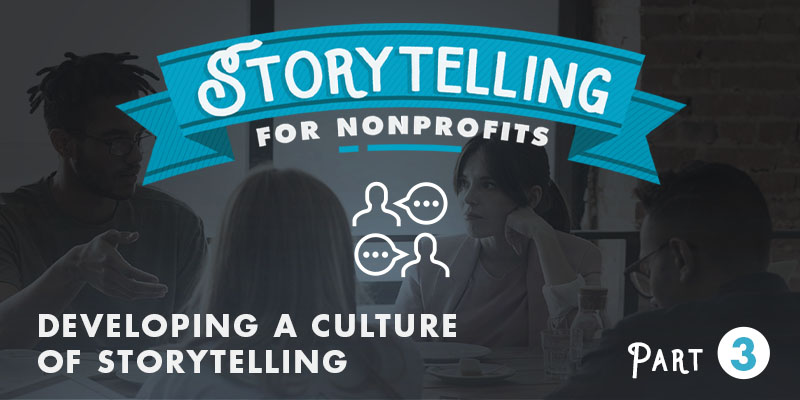In part one and two of our series on storytelling for nonprofits, we talked about the impact of storytelling on the brain, its importance and a step-by-step process of how to create a good story. You may be wondering what’s next. Perhaps you are a one-person team, overwhelmed by the thought of trying to collect stories to create and tell about your nonprofit. This is even harder if you aren’t on the “frontlines” of the work your organization does. You may not be aware of how to find those stories and develop them in the most effective way. If this sounds familiar, don’t worry. Part three of our series is for you! In this post, we’ll give you some practical steps for collecting stories internally and how to create a culture of storytelling in your organization.
The reality is, you need EVERYONE at your nonprofit to understand the importance of stories and how sharing them can further your work. Let’s get started by reviewing who can share stories and then how to help them hone their storytelling skills.
Who Can Tell Stories?
- Staff Members – Your team is an integral part of how you will collect stories. Tap into their deep knowledge of the organization and the audiences you serve. After all, they are the ones interfacing with your clients each day.
- Board Members – Board members should be some of the most passionate advocates for your nonprofit. Ask about any personal experiences they have had with the work of your organization. They probably have a memory tucked away about why they support your mission and why they give their time to it. It doesn’t have to be a direct interaction with those you serve. It could be about why they were moved to join the board in the first place.
- Volunteers & Donors – Don’t forget about these two valuable audiences. If you work at a nonprofit, you know that a huge amount of work is accomplished because of volunteers. Plus, a lot of volunteers are donors! They have probably had meaningful interactions and experiences with your organization that led them to be passionate supporters.
- Clients – Last, but certainly not least, you should be collecting stories from the clients you serve! This allows you to go straight to the source of those who have benefited from the services your nonprofit provides. Gathering stories from clients can take place in many ways – a one-on-one conversation, a check-in email sent to them, or even a survey to fill out before they leave the building. The key is to create regular check points with your clients, which naturally helps those stories come out.
Once you start collecting stories, they can be shared in many places! You can use them on social media, in email campaigns, annual reports, newsletters, in marketing materials or in appeals and campaigns. A story about the impact your work has had on the community is much more effective than a sentence about how you help people. Remember, this is about humanizing the work you do.
Now, how do we encourage a culture of storytelling at your organization? Here are a few quick tips on how to foster that culture with your entire team.
Story Prompts – Tell staff, board members or volunteers the types of stories you’d love to share. For example, prompt them with something like this: “We had a busy week here at the shelter. Did you meet any families who came in to adopt their first pet? Did someone adopt an animal that we have been hoping would go to a forever home?” Framing it this way can spark great story ideas from your stakeholders.
Schedule a Group Brainstorm – Put time on the calendar every few weeks to come together as a staff and talk about recent events. Often, one person will share something and that will prompt others in the room to share as well. You can use an example like the one above to kick off your brainstorm. This is also a great time to pause from the busyness of work and reflect together on the important work you are doing as a group. It’s easy to miss the good things happening during the grind.
The bottom line — it takes time for your entire team to understand the importance of storytelling and how to gather the information necessary to create compelling stories. At my previous nonprofit workplace, our team was hesitant to share stories, especially since we served a vulnerable population. It took some convincing, but together we put systems in place to tell our client’s stories in a dignified and anonymous way. On a practical level, we asked clients to sign photo releases, we changed all names to protect their identities, and we directed our photographer to never capture our client’s faces in pictures. It was vitally important to showcase our clients with dignity and respect.
I noticed that the more we talked as a group about stories and the more it was brought up at staff meetings, the more it improved. Soon, I had staff members taking time to send me a quick email with a story. It doesn’t have to be long! You just need the basic details to share the awesome work you do.
So, what are you waiting for? Go get your team together and start creating a culture of storytelling at your nonprofit!
Before joining TVG, Bailie Moore was the Communications Manager at a nonprofit helping the homeless. She is passionate about helping nonprofits learn how to better communicate with their audiences and tell their story. TVG would love to help your nonprofit through branding, a storytelling seminar, story mining, social media and more. Contact us here.
By Bailie Moore, Senior Account Executive at The Vandiver Group in St. Louis, Missouri
Follow The Vandiver Group on Facebook, Twitter, LinkedIn and Instagram. Read our other blogs here.

